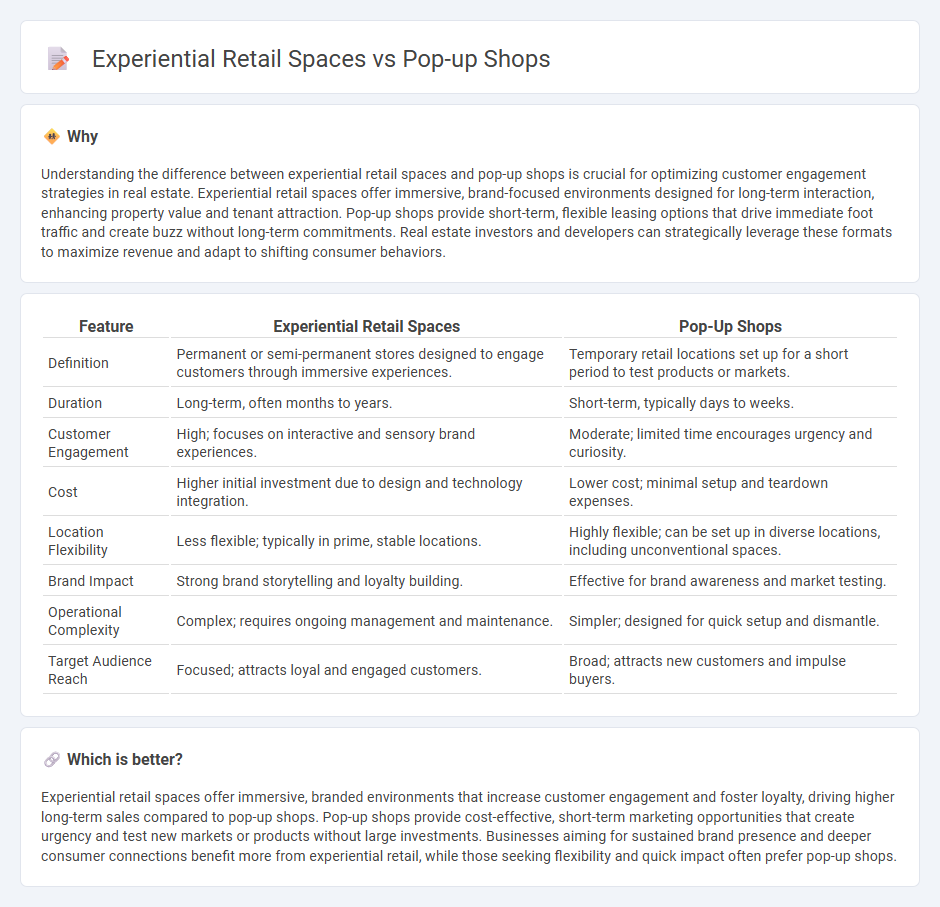
Experiential retail spaces create immersive environments that engage customers through sensory experiences, fostering brand loyalty and increased dwell time compared to traditional stores. Pop-up shops offer temporary, flexible retail solutions designed to generate buzz and test markets with minimal investment. Discover how these innovative retail formats are transforming the real estate landscape and consumer engagement.
Why it is important
Understanding the difference between experiential retail spaces and pop-up shops is crucial for optimizing customer engagement strategies in real estate. Experiential retail spaces offer immersive, brand-focused environments designed for long-term interaction, enhancing property value and tenant attraction. Pop-up shops provide short-term, flexible leasing options that drive immediate foot traffic and create buzz without long-term commitments. Real estate investors and developers can strategically leverage these formats to maximize revenue and adapt to shifting consumer behaviors.
Comparison Table
| Feature | Experiential Retail Spaces | Pop-Up Shops |
|---|---|---|
| Definition | Permanent or semi-permanent stores designed to engage customers through immersive experiences. | Temporary retail locations set up for a short period to test products or markets. |
| Duration | Long-term, often months to years. | Short-term, typically days to weeks. |
| Customer Engagement | High; focuses on interactive and sensory brand experiences. | Moderate; limited time encourages urgency and curiosity. |
| Cost | Higher initial investment due to design and technology integration. | Lower cost; minimal setup and teardown expenses. |
| Location Flexibility | Less flexible; typically in prime, stable locations. | Highly flexible; can be set up in diverse locations, including unconventional spaces. |
| Brand Impact | Strong brand storytelling and loyalty building. | Effective for brand awareness and market testing. |
| Operational Complexity | Complex; requires ongoing management and maintenance. | Simpler; designed for quick setup and dismantle. |
| Target Audience Reach | Focused; attracts loyal and engaged customers. | Broad; attracts new customers and impulse buyers. |
Which is better?
Experiential retail spaces offer immersive, branded environments that increase customer engagement and foster loyalty, driving higher long-term sales compared to pop-up shops. Pop-up shops provide cost-effective, short-term marketing opportunities that create urgency and test new markets or products without large investments. Businesses aiming for sustained brand presence and deeper consumer connections benefit more from experiential retail, while those seeking flexibility and quick impact often prefer pop-up shops.
Connection
Experiential retail spaces and pop-up shops drive customer engagement by creating immersive, interactive environments that enhance brand storytelling and product discovery. Both formats leverage limited-time availability and unique sensory experiences to attract foot traffic and boost sales conversions in competitive real estate markets. These tactics maximize the commercial use of retail properties by increasing dwell time and generating buzz around physical locations.
Key Terms
Short-term Lease
Pop-up shops offer flexible, short-term lease agreements typically ranging from a few days to several months, ideal for testing markets or launching limited-time products. Experiential retail spaces often require longer lease commitments to establish immersive, brand-focused environments that engage customers on a deeper level. Explore the benefits and strategic considerations of short-term leasing in retail by learning more about pop-up shops versus experiential spaces.
Brand Activation
Pop-up shops create temporary retail environments that generate immediate consumer engagement by offering exclusive products or events, effectively boosting brand visibility and sales. Experiential retail spaces emphasize immersive, interactive experiences that deepen emotional connections with customers, fostering long-term brand loyalty and advocacy. Explore how leveraging these brand activation strategies can transform your marketing impact.
Foot Traffic
Pop-up shops generate significant foot traffic by creating a sense of urgency and exclusivity, drawing curious consumers to limited-time experiences. Experiential retail spaces enhance foot traffic through immersive, interactive environments that encourage longer visits and deeper brand engagement. Explore how these strategies impact consumer behavior and foot traffic metrics in retail.
Source and External Links
What is a pop-up shop? Benefits, types, and how to start - Printify - This guide explains what a pop-up shop is, its benefits, and how to launch one, whether in-person or online, using Printify's services.
Pop-up retail - Wikipedia - Pop-up retail involves opening temporary sales spaces that last from days to weeks, often used for marketing, testing products, and creating unique customer experiences.
What is a pop-up shop? | Definition, history, benefits, costs | Storefront - This article defines pop-up shops as temporary stores that "pop up" for a limited time to achieve specific goals, offering flexibility and low-risk experimentation for brands.
 dowidth.com
dowidth.com